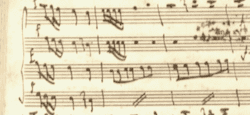A Cudworth cadence is of the most common and typical galant cadences. It combines a ③–④–⑤ bass with a complete descending scale in the upper part from ➊ to ➊. Gjerdingen named this cadence in honour of English musicologist Charles L. Cudworth (1908–1977), who first discussed this type of cadence. This is the model Cudworth gave in 1949:

Note that the first bass note can also be ①:

Typical elements are:
- a high ➊ above ③ or (the first) ①
- an appoggiatura ➐ followed by ➏-➎-➍ above ④, an appoggiatura creating a vertical augmented fourth
- ➌ above the first ⑤ (‘cadential’ six-four chord)
- ➋ above the second ⑤ (triad), often with a trill (not included in Cudworth’s model)
- a low ➊ above (the last) ①.
Instead of ➐, ♭➐ can also be used, creating a perfect instead an augmented fourth above ④:

If a less definite ending is wanted, the perfect clausula basizans (that is, a basizans ending with ➊) can be transformed in any kind of evaded cadence. The following two examples show just two possibilities. The first one doesn’t end with ➊ but with ➌, the second not with ① but with ⑥ (deceptive cadence).


And instead of starting with ③, a Cudworth cadence can also open with ⑥:

Another variant starts with ➌ instead of ➊:

Note how this makes the appoggiatura ➐ above ④ more prominent.
Select Bibliography
Cudworth, Charles. Cadence galante: The Story of a Cliché, in: The Monthly Musical Record 79 (1949), p. 176–178.
Gjerdingen, Robert O. Music in the Galant Style (New York: Oxford University Press, 2007).
